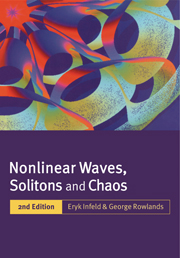Book contents
- Frontmatter
- Contents
- Foreword to the first edition
- Foreword to the second edition
- 1 Introduction
- 2 Linear waves and instabilities in infinite media
- 3 Convective and non-convective instabilities; group velocity in unstable media
- 4 A first look at surface waves and instabilities
- 5 Model equations for small amplitude waves and solitons; weakly nonlinear theory
- 6 Exact methods for fully nonlinear waves and solitons
- 7 Cartesian solitons in one and two space dimensions
- 8 Evolution and stability of initially one-dimensional waves and solitons
- 9 Cylindrical and spherical solitons in plasmas and other media
- 10 Soliton metamorphosis
- 11 Non-coherent phenomena
- Appendices
- References
- Author index
- Subject index
- Plate section
3 - Convective and non-convective instabilities; group velocity in unstable media
Published online by Cambridge University Press: 05 June 2012
- Frontmatter
- Contents
- Foreword to the first edition
- Foreword to the second edition
- 1 Introduction
- 2 Linear waves and instabilities in infinite media
- 3 Convective and non-convective instabilities; group velocity in unstable media
- 4 A first look at surface waves and instabilities
- 5 Model equations for small amplitude waves and solitons; weakly nonlinear theory
- 6 Exact methods for fully nonlinear waves and solitons
- 7 Cartesian solitons in one and two space dimensions
- 8 Evolution and stability of initially one-dimensional waves and solitons
- 9 Cylindrical and spherical solitons in plasmas and other media
- 10 Soliton metamorphosis
- 11 Non-coherent phenomena
- Appendices
- References
- Author index
- Subject index
- Plate section
Summary
Introduction
In Chapter 2 a linear theory of waves and instabilities was presented for the case of the propagation of waves in infinite and uniform media. Basically one considers the wave disturbance (in one dimension) to be proportional to exp(ikx - iωt) with ω, k satisfying the dispersion relation D(ω, k) = 0. In many problems, for example infinite media, one must take k to be real, in which case one distinguishes between stable (Imω(k) ≤ 0 and unstable disturbances for a particular k value Imω(k) ≤ 0).
Early experiments suggested that such an approach was not always sufficient. For example, experiments involving the interaction of charged particle beams with stationary plasmas consistently showed little sign of being unstable. On the other hand, all theoretical models based on the ideas outlined above unequivocably suggested the system to be unstable. In the case of plasmabeam experiments, the explanation which resolved this difficulty was given independently by Sturrock (1958) and by Fainberg, Kurilko and Shapiro (1961). The Soviet authors based their method on earlier work by Landau and Lifshitz (1959) Chapter 3. These latter authors were concerned with problems in fluid mechanics.
The resolution of this problem is based on the fact that it is not sufficient to treat the time development of a system by considering just a single k mode, but rather it is necessary to consider a spatial pulse or wave packet which is composed of a range of k values. Then unstable media can be classified into two distinct types.
- Type
- Chapter
- Information
- Nonlinear Waves, Solitons and Chaos , pp. 48 - 58Publisher: Cambridge University PressPrint publication year: 2000

